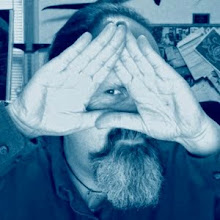The image that I presented on June 7 and 10 is a series of pictures of Chladni patterns. These patterns are produced by different frequencies of sound. (To see this in action, take a look at the above video.)
Chladni was an 18th century musician and physicist who was instrumental in the development of acoustics, which is the science of sound. Sound is made of physical vibration. (Perhaps you have heard the windows of your house rattle as a result of a car with a very loud sound system with subwoofers going down your street. Thunder will produce a similar effect.) Chladni found a very interesting way to demonstrate the physical qualities of sound—by drawing a violin bow across a plate sprinkled with sand, he produced patterns and shapes that are now known as Chladni patterns (or figures).

The science of the visualization of waves, particularly sound waves, has come to be known as cymatics, a term coined by Swiss scientist Hans Jenny (1904-1972). Jenny conducted a wide range of experiments with the way that sound affects different substances, and was able to produce Chladni patterns by using oscillators and even the human voice. Here is a photograph of a human voice pronouncing the vowel “A” (as seen in the previous post on this blog, where you will also see Chadni patterns in a drop of water and a coffee cup).

Oftentimes these Chladni patterns form mandalas or similar patterns. The word mandala comes from the classical Indian language of Sanskrit, and loosely translated, means circle. Mandalas have been produced in many forms throughout human history all around the world, from the classic Buddhist mandalas (again, see previous post), to Navaho sand paintings, the Aztec Sun Stone (a.k.a. Aztec calendar stone), and even the swastika, which is thousands of years old, and again, is seen in various forms in cultures all over the world.

Aztec Sun Stone, 1479
Mandalas are also seen in the natural world, from things like tree rings and flowers, all the way to the shape of galaxies. The natural world also provides us with that which is known as the “golden ratio”, which can be seen in things like the Nautilus shell, leaves, crystalline structure, etc. The golden ratio has also been used in art and architecture for hundreds and even thousands of years.

Nautilus shell, cross-section


Notre Dame de Paris, 1163-1345

Notre Dame de Paris
The circle itself is one of humankind’s earliest symbols, and is a mandala in its simplest form. The swastika developed from a circle overlaid with a cross. These symbols go back tens and even perhaps hundreds of thousands of years.
The circle, the cross, and the mandala in nature and in art are inextricably intertwined. These forms in many variations also exist in the vibrations of sound, as seen so clearly in Chladni patterns. The interconnectedness of the natural world is truly amazing. Although mathematics, science, and modern technology give us a deeper understanding of these phenomena, they have been part of human culture since the dawn of time.

6 comments:
Once i was in a tibetan art exposition...
It has really "inmemoriyng" me !
One of the most complex tasks is exposing simplicity. The power of sound can command, delight, rearrange and expose....it was a pleasure to visit your blog.
The Aztec Sun Stone, Notre Dame stained glass-window, a Galaxy, your Artwork. Excellent post.
thank you.
Amiable post and this post helped me alot in my college assignement. Gratefulness you on your information.
Hi Rick, I'm blind and have for years been trying to convince people of the beauty of sound. I would love to learn cymatics and present cymatics in a small exhibition but am wondering how to go about it, what tools I need, etc. Can you provide me with any suggestions or advise me of the steps?
James-- as and artist AND a musician, I too believe in the beauty and power of sound. I was totally amazed to learn that sound waves could actually create a series of mandala-like shapes and patterns. Unfortunately, I don't really know anything about the technical side of this, and can't give you any specific suggestions. My only advice would be to do some research on the Internet; I'm sure that the information is out there.
Rick
Post a Comment